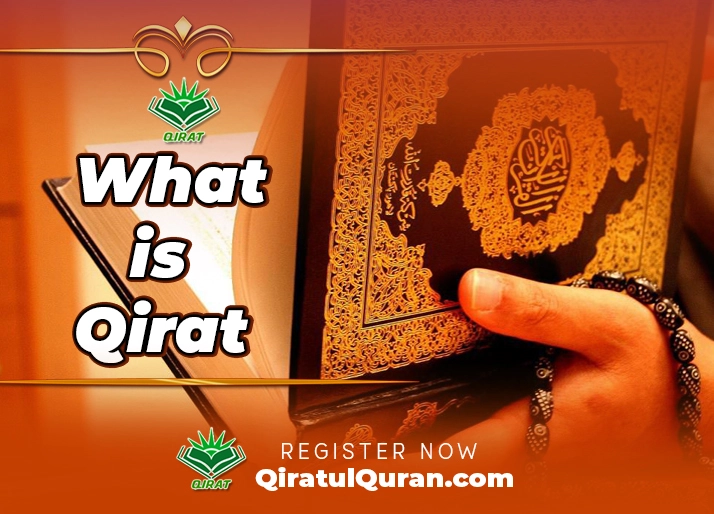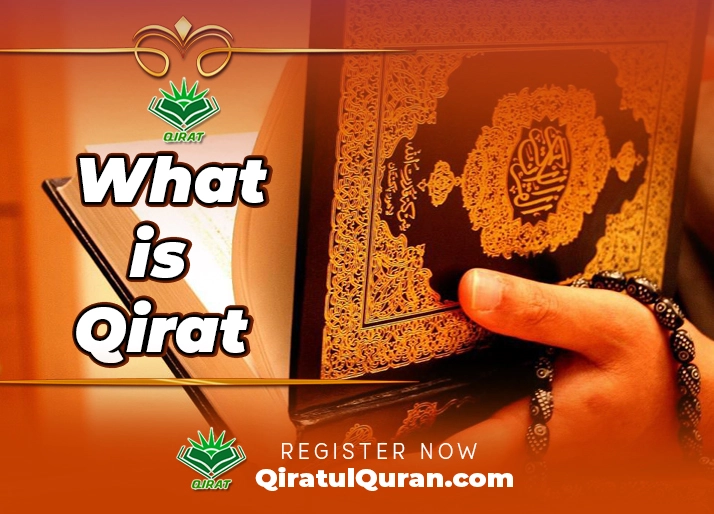
Qirat Meaning in Arabic According to the Quran and Islam
Qirat Meaning in Islam and Quran: Qirat (قرات) is an Arabic word that refers to the method of recitation of the Holy Quran. It encompasses the rules of pronunciation, intonation, and cadence when reciting the verses of the Quran. Adhering to the proper Qirat is very important for Muslims as it directly impacts the meanings derived from the holy book.
There are 10 recognized schools of Qirat, each named after the prophet or sahabi who narrated them:
Schools of Qirat
- Qirat-e-Naafi
- Qirat-e-Ibn Katheer
- Qirat-e-Abu Amr
- Qirat-e-Ibn Aamer
- Qirat-e-Aasim
- Qirat-e-Hafs
- Qirat-e-Kisaai
- Qirat-e-Duri
- Qirat-e-Yaqub
- Qirat-e-Khalaf
These schools have minor differences between them when it comes to tajweed rules, pronunciations of certain words, and intonations. However, the overall messages and meanings derived from the various Qirats remain the same.
Origins & History
The rules of Qirat or reciting the holy book properly can be traced back to the time of the Prophet Muhammad (PBUH) himself. He would recite the revealed verses of the Quran to his companions in a particular rhythmic style. The sahaba would then memorize and learn to recite in the same manner.
Several sahaba became renowned for their beautiful Qirat and tajweed, including Ubayy ibn Ka’b, Abdullah ibn Masoud, and Zayd ibn Thabit. As Islam spread to different regions, slightly varied recitation styles emerged organically.
Standardization of the Qirat
During the time of the third caliph Uthman ibn Affan, slight differences were observed in the Qirat traditions of various regions. Uthman ordered the gathering of all verses into a unified written Mushaf using the native Qurayshi style of recitation. This became known as the Uthmani script Mushaf.
Uthman then ordered all other regional copies of Quranic verses and records to be burned. This ensured there would only be one standard version moving forward. However, the multiple recitation styles continued to co-exist peacefully alongside the Uthmani Mushaf.
Centuries later, various Islamic schools and scholars would further study, certify, and document the rules of the 10 main qirat traditions that had been organically established and passed down from generation to generation through an unbroken chain of authentic narrators.
Qirat meaning in the Quran
Here are the key points about the meaning of Qirat in the Quran:
- Qirat (قرات) refers to the proper oral recitation method and techniques used when reciting the Holy Quran.
- Adhering strictly to the intricate rules of Qirat (pronunciation, intonation, length of vowels, etc.) is crucial for accurately conveying the meanings of Quranic verses.
- There are 10 main schools of Qirat, each named after the sahabi or tabi’ who narrated the mode of recitation in an authentic chain back to Prophet Muhammad (PBUH). These include Naafi, Ibn Katheer, Asim, Abu Amr, Ibn Amer, etc.
- Though there are multiple Qirat schools, they all precisely preserve the essential messages and teachings of the Quran. The variation adds richness, depth, accessibility, and memorization flexibility to the beauty and understanding of the Holy Book.
- Rules of Qirat encompass techniques like proper Makhraj points, letter characteristics, Ghunnah, Maad Sakt, and more to achieve accuracy in recitation along with musical, soul-stirring rendition.
So in essence, “qirat” means the validated technical style of oral transmission from the Prophet Muhammad’s living recitation teachings that allow precise extraction of meaning from the Holy Quran. Mastering Qirat is a high Islamic discipline and devotion to correctly acquiring divine knowledge.
Qirat Meaning in Urdu
The word “Qirat” meaning in Urdu refers to the “style of recitation of the Holy Quran”. Specifically, Qirat refers to the traditional method of reciting the Quran that was transmitted from Prophet Muhammad (PBUH) to his companions (sahaba) and then onward to the followers (Tabi’in) in the same manner and style. This style of recitation has continued to be adopted by Quran reciters over the generations.
Qirat encompasses the rules for pronouncing each letter, determining the duration of vowels (mad), applying proper stops (waqf), and restarts (Ibtida) when reciting. Adhering to proper Qirat allows for the accurate communication of the meanings and messages of the Quranic verses.
There are 10 famous imams of Qirat whose narrations of recitation are well-known. Although there are slight outward differences between these imams’ qirat methods, there are no contradictions in the inherent meaning or essence of the Holy Quran. The variations add a layer of beauty and clarity.
Qirat Meaning in English
Qirat (pronounced as “Kiraat”) refers to the rules governing the proper recitation and pronunciation of the Holy Quran. It is an Arabic word that encompasses the tajweed guidelines that must be applied when reciting the Quran to accurately convey the meaning and message of its verses.
Specifically, the key elements covered under the rules of Qirat include:
- The precise pronunciation of each letter from its correct point of articulation (Makhraj)
- Applying the proper vowels (harakat) and prolonging vowel sounds where required
- Knowing which letters have inherent characteristics that impact pronunciation (such as jahr, tafkhim, etc.)
- Observing rules for nasalization (Ghunnah) and merger of certain letters (Idgham)
- Determining the proper stops (waqf) between verses and phrases
- Beautifying the recitation through appropriate rhythm, tone, and melody
By adhering to the disciplines of tajweed and applying the rules of Qirat, the reciter ensures that each letter, word, and verse of the Holy Quran is being accurately articulated from the throat in the same form and meaning as it was revealed by Angel Jibreel to Prophet Muhammad (SAW). This grants a deeper understanding of the Divine message.
Qirat Meaning in Namaz (Salat)
Qirat does not have a direct relevance or meaning when it comes to the salat (namaz). However, here is how it relates indirectly:
In salat, Muslims have to recite verses of the Holy Quran in Arabic during certain positions. For example, reciting Surah Fatiha in the standing position during every Rakat.
Since the validity and perfection of salat require maintaining proper tajweed rules when reciting the Quranic verses, understanding the principles of Qirat becomes important.
Some ways that Qirat’s connection comes into play for salat are:
- When learning to properly pronounce Arabic letters from the correct Makhraj points to avoid errors when reciting Fatiha or other surahs in salat
- Knowing which letters can be merged (Idgham) and joined when transitioning between different verses
- Applying the proper Ghunna (nasalization) for nose letters like م and ن when reciting within namaz
- Observing the proper timings and counts for medd letters (like الرحمٰن) during recitation in Qiyam or ruku
So in essence, while Qirat itself does not directly apply to the physical motions and steps of offering namaz, having command over it facilitates proper tajweed in the recitation aspects that are integral parts of salat. This prevents distortions in conveying Quranic meanings.
Purpose & Impacts of Different Qirats
Although there are multiple Qirat schools, they all lead to the same overall messages and essence of the Holy Quran. There are however some subtle differences that expand, elaborate on, or clarify the meanings of certain verses. The different Qirats are said to add beauty, depth, and insight into the verses of the Quran.
Some key purposes and benefits served by multiple Qirat traditions include:
Facilitating Memorization
In the early days of Islam, there was a great emphasis on memorizing the Quran word for word. The recognition of multiple musical styles of recitation facilitated people of different dialects across various regions to easily pick up and accurately memorize the revelation.
Appreciating Linguistic Depth
The Arabic language is extremely sophisticated, intricate, and vast in its vocabulary and expressions. The variation in the reciters and Qirat schools allows more scopes for people to study, analyze, and appreciate the immensity of the meanings and linguistics embedded within the limited words and structures of the Quranic verses. Even native Arabic speakers have to frequently refer to classical Arabic dictionaries to fully unpack Quranic verses.
Adding Flexibility in Ibada
Islam is a truly universal and flexible religion. For example, there are many valid styles of offering salah taught by the different madhabs even though they all fulfill the same purpose of namaz. Similarly, allowing flexibility via multiple recitations facilitates more people with different needs, styles, and capacities to connect with and absorb the Holy Quran.
Accommodating Dialectical Differences
Arabic has many local and cultural dialects. Recognizing multiple styles of oral Quranic rendering allowed people of different backgrounds to continue benefitting from the customized styles of recitation as per their dialects, without compromising on the accuracy of meanings.
So in summary – having different Qirat immensely expands accessibility, depth, absorption capacity, applicability, and overall connection for the worldwide Muslim ummah with the words of the Divine Creator.
Key Tajweed & Qirat Rules
While each Qirat school can have particular techniques, there is a fundamental set of tajweed principles that underlie any authentic method of Quranic recitation:
Makhraj
This refers to the precise point of origin within the mouth cavity from where each letter should emanate. There are 17 Makhraj identified in the classical Arabic language that generate the entire alphabet system. Selecting the wrong Makhraj can lead to saying an entirely different letter that changes Quranic meanings.
Tajweed Letter Characteristics
Letters have special innate qualities that impact how they interact with other letters in a word, including characteristics like jahr (clear), shafawi (whistle), Qalqalah (bounce), etc. Applying the right technique required for each letter is crucial.
Ghunnah
This technique is used on nasal letters like م and ن, where the sound is extended and resonates from the nose for 2 to 4 counts. Quran recitation relies heavily on a very structured and planned utilization of the Ghunnah technique.
Maad Sakt
One of the keys to the musicality of Qirat is controlling the lengthening and shortening of various letters during recitation. There are detailed rules on the counts/beats for which certain letters should be extended vs clipped shorter for the desired impact.
Through her divinely guided and inspired recitations, Prophet Muhammad’s (SAW) wife Sayyida Hafsa perfectly encapsulated these technical rules which were passed down in traditions and eventually formally compiled into the foundational works of tajweed literature.
Maintaining Accuracy of Quranic Recitation
Given the utmost religious and spiritual importance of the Holy Quran, there are very strict requirements and quality control to become a certified Quran reciter, known as a Qari (if male) or Qaria (if female):
Isnad & Ijazah
All recognized Qurra (reciters) must receive their ijazah certification of Qirat proficiency through an unbroken ‘golden chain’ of credible narrators that stretches back to the Prophet (SAW) himself. This chain of teachers is referred to as isnad.
Verifying the authenticity of a reciter’s isnad and ijazah protects the integrity and accuracy of Quranic rendition. There can be no errors or deviations, as not even a slight change in pronunciation or rhythm can be accommodated if it distorts the original meanings.
Active Listening Community
Within the Muslim ummah, there exists a very learned community of active listeners who scrutinize each letter uttered by reciters during competitions or live events. Even minor Qirat errors are immediately highlighted and must be corrected by the qari/qaria. This ensures quality control.
Quranic Recitation Competitions
There is an entire professional field dedicated to studying, teaching, and judging the ten qirats in competitive settings. Islamic Quranic events routinely host worldwide competitions to select the most exceptional reciters for the best Qirat award, also referred to as:
An-Nashid al-Quran
Judging criteria focus on the technical perfection of rules for each Qirat, as well as beautiful voice quality and melodious style Like the Maqamat Quran that touches the soul. Egypt, Saudi Arabia, UAE, Qatar, and other Muslim nations actively promote these competitions to motivate perfecting the art of Qirat.
So in summary, Qirat Meaning in Islam and Quran, Qirat is the melodious technique of correctly pronouncing each letter and word in the Holy Quran to precisely convey intended meanings, as preserved and passed down in traditions throughout generations since the Prophet Muhammad’s (PBUH) own recitations. Mastering the complex disciplined science of Qirat and tajweed is seen as an act of devotion.





